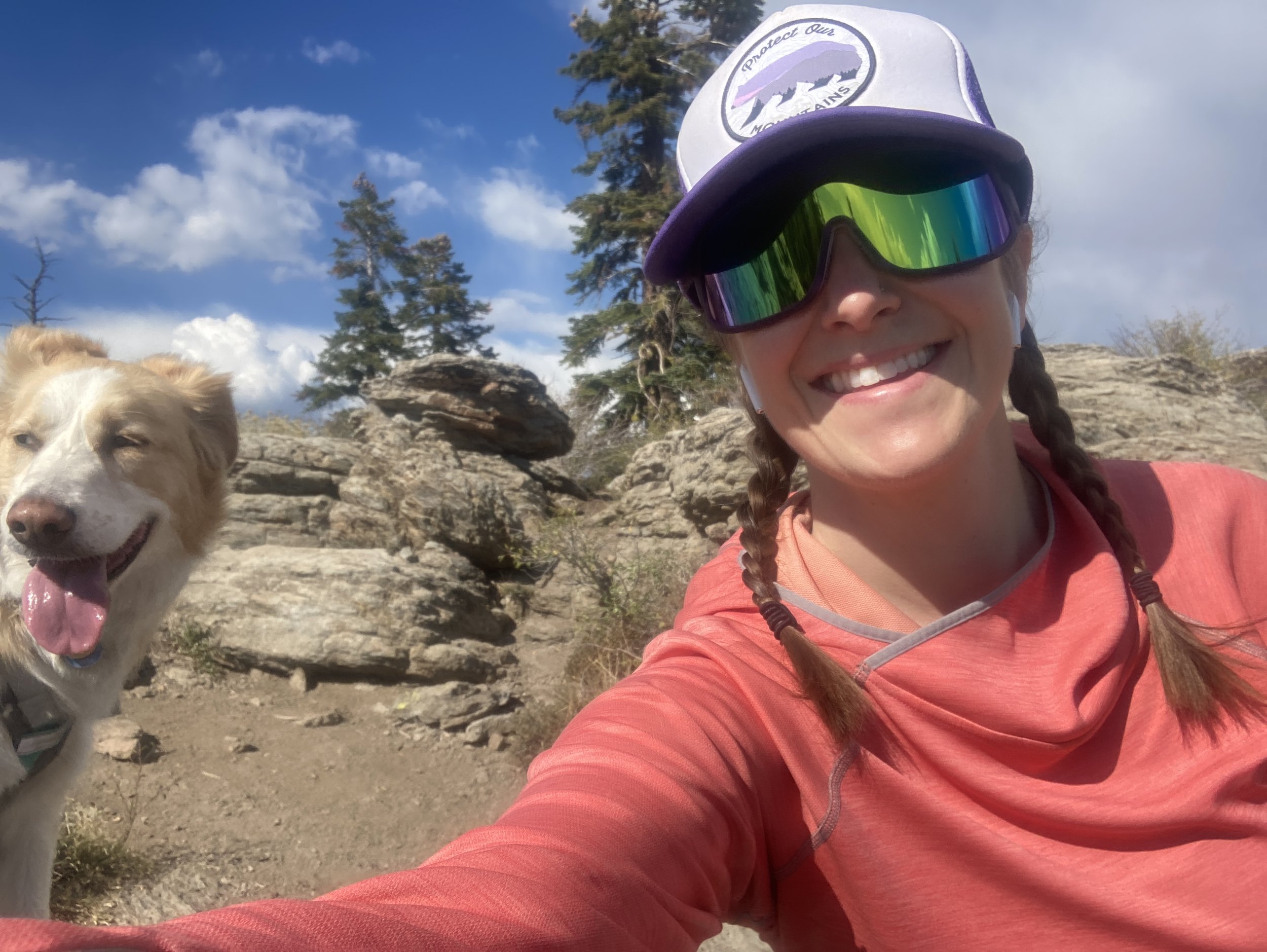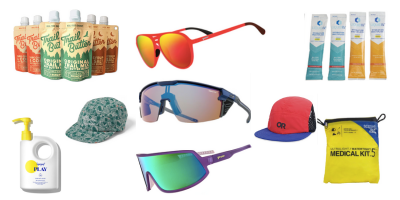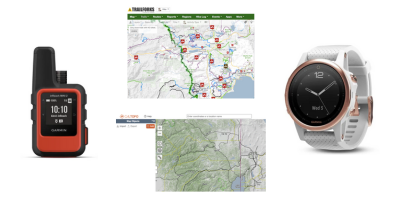Trail Running Gear
Despite the stubborn snow blanketing the Sierra, trail running season up here in Truckee-Tahoe will be here before we know it! While I’ve done a fair amount of trail running since moving to Tahoe, adopting a pandemic dog back in 2020 got me even more into trail running. Here’s my list of trail running essentials, with some examples of my favorite gear.
You can get started trail running with basic running gear, but trail runners are something I’d recommend investing in fairly early on. Trail runners tend to have lugged, softer soles for better grip, tougher uppers (the “fabric” part of the show) that hold up better to rougher trails, and a stiffer mid sole that helps with support and uneven surfaces.
Here are three trail runners I’ve had and liked:
The Altra Lone Peak is the trail runner I’m currently using. It’s a GREAT shoe if you have duck feet (wide forefoot, narrow heel), but I found them a little floppy/unsupportive, compared to my past trail runners. I mostly solved that with a pair of Superfeet insoles and lacing them tighter than I’m used to. Buy: Altra Lone Peak 7 ($150), Altra Lone Peak 6 ($88-$140)
The Salomon Speedcross were my previous trail runners. I loved the traction, level of cushion, and the speed laces which let me make micro adjustments to the tightness, but my wide forefeet busted through the mesh sides before the rest of the shoe fully wore out. If you have more rectangular feet, I’d highly recommend. Buy: Salomon Speedcross 5 ($140), ($98- limited sizes)
The Saucony Peregrine was my first pair of trail shoes, several versions ago. I really liked how light weight and precise these were, but that meant they weren’t quite as rugged as other trail runners. They were good crossover shoes if you don’t want to get a separate pair of trail and road shoes. Buy: Saucony Peregrine 13 ($140) , Saucony Peregrine 12 ($65)
Other than good shoes, I think the most important piece of gear to invest in is a hydration vest. After some bad chafing incidents running in a small hiking pack, I bought a running specific vest, and I’m glad that I did.
I currently have the Ultimate Direction Adventure Vesta. I love how much stuff I can pack in it for it’s small size. It’s light weight and cool in hot weather with a ton of pockets - including accessible ones on the front that can fit your phone. The only downside is that it’s on the softer side, so feels a little unsupported when I’ve got a full hydration bladder in it. Buy: Ultimate Direction Adventure Vesta 6 ($140), Adventure Vesta 5 ($117)
The Camelbak Chase is supposed to be for mountain biking, but I’ve worn it trail running as well and it works great for that. It’s a good choice if you want a pack that works for multiple sports. It doesn’t have as many front pockets as running specific vests, but you can still fit plenty in the pack overall. Buy: Camelbak Chase ($60), Camelbak Chase ($75)
While generally trail running and road running have a lot of crossover in running clothes, there are few things I like that are more trail specific, especially on longer runs.
I am a convert to the sun shirt life - it’s so nice to not worry about reapplying sunscreen to my arms/chest/neck. I would definitely recommend getting one with a hood for extra sun protection.
I have two Patagonia Tropic Comfort sun hoodies. The sleeves are long enough (something I often have a problem with), the hoods are comfortable, and they provide full coverage without being too hot. The downside is that they seem to stain pretty easily - I’d recommend getting a pattern which will help hide the stains. Buy: Patagonia Tropic Comfort ($99)
My husband has the men’s version of the Outdoor Research Echo, and he wears it a ton. It’s held up well to all the wear, and he recommends. Buy: Outdoor Research Echo ($79)
For shorts, I like to wear ones with a slightly longer inseam to help with chafing.
I really love these cheap shorts - 90 Degree By Reflex High Waist Power Flex Yoga Shorts. I’ve been wearing them pretty much weekly for almost three years for hiking, running, yoga, and short Peloton rides, and they’re still in great shape. I wish they had a thigh pocket, but for the price, they can’t be beat. Buy: 90 Degree By Reflex High Waist Power Flex Yoga Shorts ($25 for 2 pairs)
The REI Co-op Swiftland with a 5” inseam have a wide comfortable waistband which is nice because I sometimes get bloated on long trail runs or hot hikes. Buy: REI Co-op Swiftland ($60)
No matter how perfect the weather forecast, I like to bring a wind and rain layer on my trail runs as a day can go from warm and sunny to dangerously wet and cold quickly in the mountains. A hooded wind shirt will wet through much faster than a true rain jacket, but can offer some level of protection against the cold and wet and is much smaller and lighter. When the probability of rain is low, I’ll usually risk it and bring just my wind shirt.
I’m so happy with my Patagonia Houdini. It packs very small (and can be stuffed in even smaller spaces) and the level of protection it provides is incredible. It’s definitely on the pricier side compared to other wind shirts, but I think it’s worth the price. Buy: Patagonia Houdini Jacket ($109)
The Houdini is the only wind shirt I’ve had, but I have heard good things about the Mountain Hardwear KOR Airshell, which is a much lower priced option. Buy: Mountain Hardwear KOR Airshell ($78)
Despite the risk of sock lines, I wear taller socks when I trail run. Long runs on uneven terrain require more protection from the elements.
Crew height socks help protect my lower legs from branches, roots, and even some rocks. My favorites for trail running are the Smartwool crew socks - no uncomfortable seams, no chafing, no blisters. I do wish they made a pair with more padding in high pressure areas while still light weight on top. Buy: Smartwool Athlete Edition Crew Socks ($27)
Even when I’m not worried about overgrown trails, I like socks that come well above the top of my shoes, like the Smartwool Ankle Crew Socks. Buy: Smartwool Ankle Crew Socks ($13-$21)
Sun safety is super important in trail running - you’re outside for long periods of time, at high elevation, and maybe above the treeline.
Even with a sun hoody, I slather on the sunscreen. Supergoop Play is one of my favorite. It’s reef friendly, good for sensitive skin, and sweat and waterproof. I like that you can buy it in bulk for home use or to fill reusable containers to bring along. Buy: Supergoop Play ($68 for 18 oz)
I wear sunglasses any time it’s not completely dark outside, and I bring out the big guns for trail running. I like ones that cover most of my face like Goodr Look Ma No Hands ($45). If I’m worried about reflection off light colored granite or snowfields, I like the Julbo Ultimate Cover ($180). If I’m in a forested area with a mix of light and shadow, I like a red or pink lens like the Goodr Captain Blunts Red Eye ($35)
My final piece is a brimmed lightweight hat like the REI Co-op On the Trail Hat ($27) or the Outdoor Research Swift Air ($31-$35) that wick sweat.
There are a few other things that I always have in my pack - a small first aid kit like the Adventurelite Medical Kits Ultralite .5 ($23) and food. On really long runs, I try to pack some real food like sandwiches and chips, but also rely on gels and liquid nutrition.
Trailbutter is kind of the best of both worlds between real food and “sports nutrition”. It’s shelf stable, squeezable nut butter that gives long lasting energy. Plus it tastes great. Buy: Trailbutter ($48 for a six pack)
As far as gels go, I’m a new fan of Maurten Gels. They come in both caffeinated and non, and the texture is more like unflavored jello than the typical gel. I prefer it, but YMMV. Buy: Maurten Gels Combo Pack ($50 for 12)
Liquid IV is my go to for electrolyte beverage. It’s low calorie, so it’s not going to be enough for fuel on it’s own, but I like it to supplement my other food. Buy: Liquid IV Mix Pack ($15 for an eight pack)
While people have been trail running for decades without technology or gadgets, I like a few things for route planning and following, safety, tracking, and training.
The Garmin Fenix is my current GPS watch. While there are models more specific for trail running, it works great as a day to day smart watch and has great battery life for long outdoor adventures. Buy: Garmin Fenix 7 ($699) , Garmin Fenix 5s ($269)
Since my GPS watch doesn’t have a mapping capacity, I use trail mapping apps for route planning and finding. Because mountain biking is my main sport, I’ve found that Trailforks (free - $2.99 per month) works best for me overall - and it also works fine for trail running locally. Caltopo seems to be the best free option, with lots of trails that don’t show up on Trailforks. It’s not quite as straightforward to use, but I’m learning.
We recently bought a Garmin inReach Mini 2 ($390), which can be used to check in with friends and family when out of cell service as well as summon emergency responders if you or someone in your party is injured. We hope to never have to use the emergency function, but we’re glad to have it, especially in the backcountry.
Disclosure: Some of the links in this post are affiliate links. If you make a purchase, I receive a small percentage of the sale as compensation – at no additional cost to you. I promise to only recommend products that I use and enjoy!




